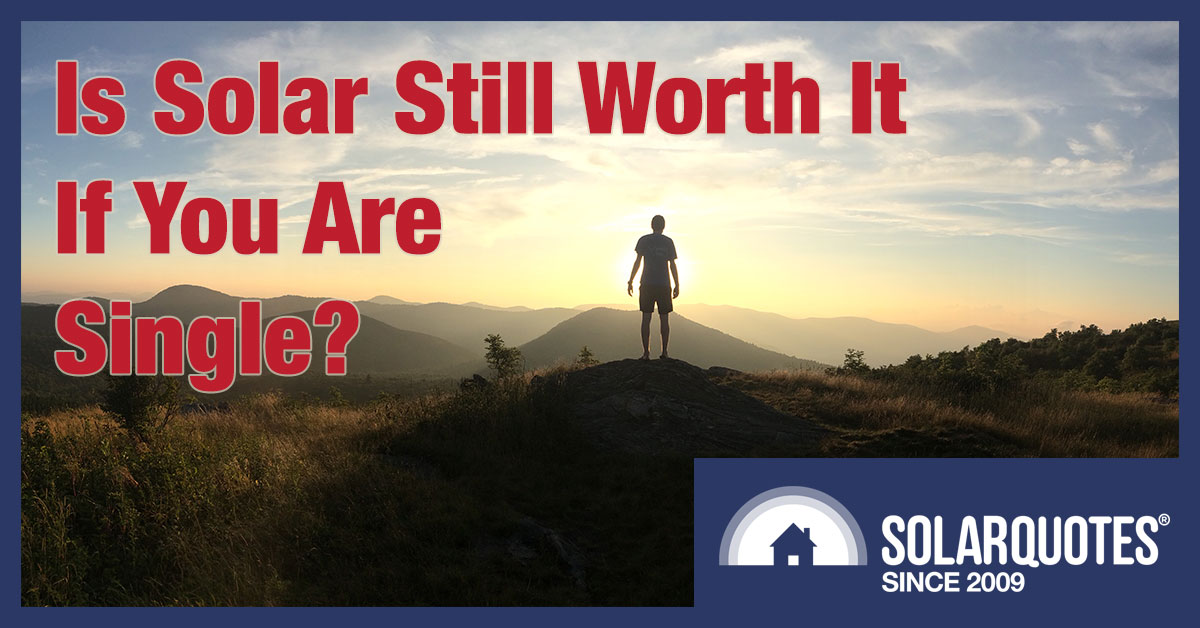
I’m So Lonely! Will Solar Panels Fill The Aching Void In My Heart? And Do I Have To Pay Them Folding Money?
If you ask me,
“Hey Ronald, should I get solar power?”
My answer will be,
“Hell yeah, fill your roof!”
If you then say,
“But I live by myself, so I’m not sure it makes sense for me.”
I’ll reply,
“Eh, it’s probably fine. I personally see no point in worrying. This is because the worst thing that can happen is you’ll lose money, and you’re not me.”
If you respond with,
“Ronald, please stop being lazy and provide some information on how long solar is likely to pay for itself for single people, so I can make an informed decision on whether or not it’s worthwhile for me.”
I’ll say,
“All right, but only because it resembles work and I’m supposed to do some of that every now and then1.”
This article investigates whether solar power makes sense for single-person households with corresponding low electricity bills.
I’ll estimate solar’s payback period for…
- An unrealistically bad situation where solar energy self-consumption is zero. This will show how long the payback period will be in a worst-case situation2.
- The payback period where electricity consumption, including solar self-consumption, is typical for a single occupant household.
- A situation where solar electricity self-consumption is higher than average — either because electricity consumption is well above average or because most consumption occurs during the day.
After that, I’ll determine the payback times of smaller solar systems and show how single-occupant households will often be better off with a larger system — provided they have space on their roof.
While I can give you an estimate of how long solar power will take to pay for itself for a person living on their own, whether or not it makes sense for you will depend on your individual circumstances and personal preferences. But even if you’re a single person who lives for the moment, investing in solar panels can reduce or eliminate electricity bills which makes it a lot easier to live a carefree life.
An Unrealistically Bad Scenario — Feed-In Tariff Only
To start, I’ll show how long it takes solar to pay for itself if no electricity is used during the day. This means zero solar energy is consumed by the home and it’s all exported to the grid for a feed-in tariff. This is not a realistic situation. Every home uses some electricity during the day, even if it’s only used by some people to run an alarm clock they keep next to their coffin.
The reason I’m doing this is to show no matter how little solar energy is self-consumed, provided an electricity plan with a good feed-in tariff is chosen, solar can pay for itself in what most people would consider a reasonable period of time. Except in Western Australia where the payback time is unreasonable because there are no good feed-in tariffs there.
To work out the feed-in tariff-only payback time in each capital I’ll need to know the following…
- The size of solar system.
- Its cost.
- What its annual output in kilowatt-hours will be.
- The solar feed-in tariff.
Solar Power System Size (Capacity)
I’m going to assume a 6.6 kilowatt solar system is installed. The large majority of Australian homes can install a system this size and export all the surplus energy produced. While this may seem larger than what a single person requires, I’ll look into installing a smaller system later. Some single people may even want to install a larger system if their electricity consumption is high or so they’ll be prepared when they get a home battery, an EV, or build an electrified combat arena.

You wouldn’t believe what his bills were like before getting solar.
Solar Energy Generation
I’ve determined the annual generation3 of a 6.6 kilowatt solar system in each capital with the following two assumptions:
- Panel tilt is 20 degrees. This is a nice round figure between the two most common roof tilts of 15 and 22.5 degrees.
- Annual output is 95% of a north-facing system because not everyone can place all their panels facing directly north or close to it.
Feed-In Tariffs By Capital
I found out the best feed-in tariffs in each capital using the SolarQuotes Electricity Plan Comparison tool. At the moment this can only show flat tariff electricity plans, but we’re working on it so it will also be able to compare time-of-use and other demand tariff electricity plans. (This isn’t easy to do, otherwise we would have done it already.)
The best feed-in tariffs available in each capital are:
- Adelaide 13 cents
- Brisbane 11 cents
- Canberra 10 cents
- Darwin 8.3 cents
- Hobart 10 cents
- Melbourne 11.7 cents
- Perth 4 cents
- Sydney 13 cents
As you can see, Adelaide and Sydney are neck and neck with the highest feed-in tariff, while Perth has the worst.
I Expect Feed-In Tariffs Will Soon Rise
I expect feed-in tariffs to rise for most Australians in July, but Victorians will have to wait until the new year for an increase. As for Western Australians, I’m afraid they’ll only see an increase if their state government decides to stop ripping them off so much.
Feed-in tariffs should increase because the economy is picking up and this is pushing up wholesale electricity prices. If the recovery is strong it may cause another feed-in tariff increase in 2023. In addition to this, the closures of the Liddell coal power station in April 2023 and Earing coal power station in August 2025 will also boost wholesale electricity prices. While the medium to long term trend is for feed-in tariffs to fall thanks to expanding solar capacity, I’m not expecting them to drop for the next few years. For these reasons, I won’t bother to account for falling feed-in tariffs when determining payback periods.
Solar System Price
I’m going to assume the 6.6 kilowatt solar power system costs $6,000. This isn’t enough to pay for the best solar hardware available, but this article is for people who want to know if solar will pay for itself quickly enough for them, so I won’t consider expensive systems that may have panels with 40-year warranties.
What $6,000 can cover is a system with reliable components from an installer who does high-quality work. You can expect it to operate for a very long time without problem, which is not something you can expect if you don’t use a good installer. It doesn’t matter how good the components are, things can still go horribly wrong if a system’s installation is shoddy.
If you are wondering how you can make sure you’re installer is good, that’s what SolarQuotes exists for. Follow this link, enter your postcode, answer the questions that come up as best you can, and you can receive quotes from installers that my boss, Finn, has personally vetted so we know they do good work. Finn’s confident he does a good job selecting installers, so he backs them up with our Good Installer Guarantee.
Regional Price Variation
The average cost of solar is not the same in every capital. Solar power systems tend to be moderately more expensive in Melbourne and considerably more expensive in Hobart and Darwin. Perth has the lowest cost solar in Australia. I’ll keep the price at $6,000 in each capital for simplicity, but it’s not difficult to compensate for different prices. If you pay 20% more add 20% to the payback time and if you pay 10% less, reduce the payback time by 10%.
Scenario #1: Zero Self-Consumption
Using the annual output of a 6.6 kilowatt solar system in each capital it’s easy to determine how long it will take the highest feed-in tariff available to equal the $6,000 cost of the system:
Even in this unrealistically bad situation, it takes under 7 years for every capital on the mainland east of Dumbleyung. It’s a little over 8 years in Hobart, thanks to low solar output, and it’s tragically long at over 14 years in Perth, due to their unfairly low solar feed-in tariff.
The shortest payback time is in Melbourne and is indicated by the light blue section on its column. This is the payback period if the $1,400 Victorian Solar rebate is used.
These payback periods rely on the average feed-in tariff not changing. Since I’m expecting an increase for everyone who isn’t Western Australian, this doesn’t seem unreasonable to me for the next four years or so. After that things become more uncertain. But I’m not expecting feed-in tariffs to disappear anytime soon or even in my lifetime4.
What If You Are Not A Vampire?
In real life, there are very few vampires who use zero electricity during the day. Even in Toowoomba vampires are less than 8% of the total population. So payback periods in real life should be considerably better. But single-occupant dwellings generally don’t use much electricity and for people who are rarely at home during the day, the payback period may not be a great deal better than with zero solar energy self-consumption.
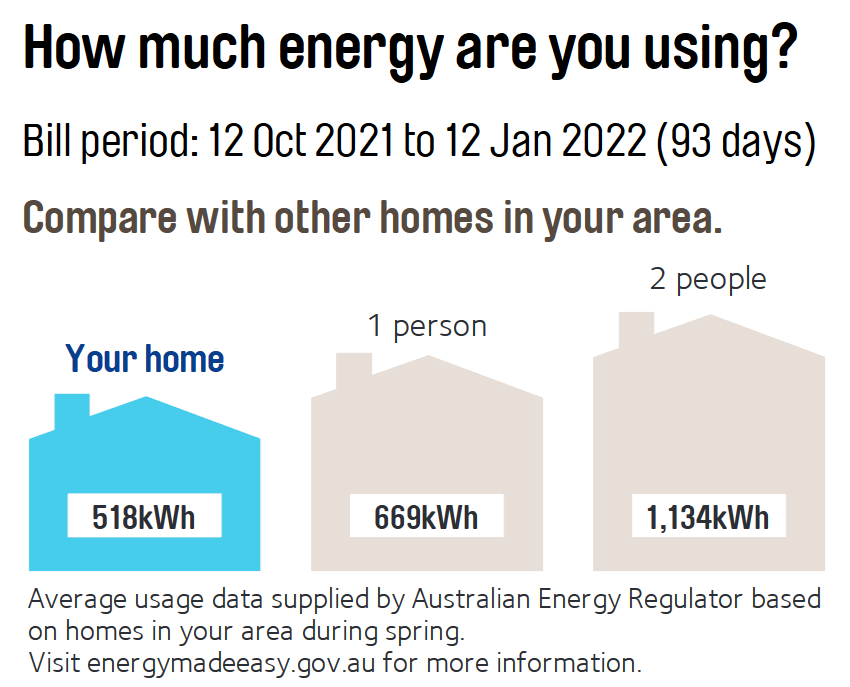
This graphic from an electricity bill shows the average consumption of a one-person dwelling in Adelaide averages 7.2 kilowatt-hours per day in spring, while the person who received this bill only averaged 5.6 kilowatt-hours per day. Note electricity consumption is usually lowest in spring and autumn.
The average amount consumed by single-occupant homes varies considerably depending on location. The average electricity consumption for a typical single occupant home without a swimming pool, underfloor heating, or electrified combat area for each capital is…
- Adelaide 2900 kWh annually, 8 kWh daily
- Brisbane 3200 kWh annually, 8.8 kWh daily
- Canberra 5380 kWh annually, 14.7 kWh daily
- Darwin 3,300 kWh annually, 9 kWh daily
- Hobart 5940 kWh annually, 16.3 kWh daily
- Melbourne 3100 kWh annually, 8.5 kWh daily
- Perth 2,900 kWh annually, 8 kWh daily
- Sydney 2900 kWh annually, 8 kWh daily

I’m not including energy use by electrified combat arenas because it’s too variable — despite being fun for all ages.
How Much Self Consumption For Singles?
For single-occupant households that consume the average amount in each capital, their solar electricity self-consumption percentages will be:
- Adelaide – 14%
- Brisbane – 15%
- Canberra – 26%
- Darwin – 15%
- Hobart – 35%
- Melbourne – 17%
- Perth – 13%
- Sydney – 15%
These are averages, so solar self-consumption will be higher if the occupant is often at home during the day or an effort is made to shift electricity consumption to when the sun is shining. This can be done by putting electric hot water systems and other devices on timers. Self-consumption will be lower if the occupant is usually out during the day and makes little effort to shift electricity consumption to the daytime.
I’ll use the above self-consumption figures to determine a more realistic payback time than what looking at feed-in tariffs only gave us, but first I’ll need to work out what households are likely to pay for electricity during the daytime.
Daytime Electricity Prices Are Falling
In the distant past, a whole 6 years ago, almost every home had a flat tariff and was charged the same amount per kilowatt-hour of grid electricity consumed, no matter when it occurred. But now we have smart meters, many homes have time-of-use tariffs and some, tragically, even have demand tariffs5.
Some people prefer a time-of-use tariff. Some would prefer to have a flat tariff, but get stuck with time-of-use one because their local network makes it difficult or impossible to change back to a flat tariff. Because time-of-use tariffs are becoming more common, I will use the typical daytime price of electricity during the day on a time-of-use tariff in each capital.
For the capitals, the typical costs of daytime electricity on a time-of-use tariff which isn’t seasonal and charges consistent rates over a year are:
- Adelaide – 26 cents
- Brisbane – 22 cents
- Canberra – 18 cents
- Darwin – 27 cents
- Hobart – 14 cents
- Melbourne – 19 cents
- Perth – 29 cents
- Sydney – 22 cents
Scenario #2: More Realistic Self Consumption
Using these figures to calculate payback periods while keeping feed-in tariffs the same gives the following:
After taking typical self-consumption for a single occupant into account, payback periods are considerably better. For all the mainland capitals, except one, the payback period is around 5 years or less. In cloudy Hobart, it’s 7.1 years, while Perth is the worst at 7.9 years. While Perth still has the longest payback period, it’s close to half what it was before solar self-consumption was considered.
So if you are not in Perth or Hobart, and your electricity use if fairly typical, then solar power is likely to pay for itself if you think you’re likely to stay where you are for around 5 years or more.
Scenario #3: High Electricity Consumption Singles
So far I’ve shown the payback period for…
- An unrealistic situation where no solar energy is self-consumed, and…
- Typical solar self-consumption for a single occupant home.
Now I’ll work out the payback period for a household that uses 50% more electricity than a single occupant typically does. This is as much as the typical 2-3 person household.
Keeping all prices of daytime electricity and feed-in tariffs this same causes the payback period to come to:
With 50% higher than typical electricity consumption, the payback period in both Hobart and Perth is under 7 years, while it’s under 5 years everywhere else. The shortest payback period is 4 years in Adelaide and Melbourne when the $1,400 Victorian Solar rebate is used.
Smaller Systems May Give Faster Payback — But Often Don’t
Installing a solar system smaller than 6.6 kilowatts can give a shorter payback time. Unfortunately, it often won’t, because halving the size of a solar power system doesn’t halve its cost. A typical 3 kilowatt system will cost roughly one-third or more per watt of capacity than a 6.6 kilowatt system. Because of the higher cost per watt, whether or not a small system will have a shorter payback period than a larger one will depend on its price, location, feed-in tariffs and electricity prices.
Even in situations where installing a smaller solar system will reduce the payback period, this may not be the best financial choice to make because it will also reduce the total savings on electricity bills. Often, the solar power system that’s the best overall investment isn’t one with the shortest payback period, but one that provides greater annual savings.
Smaller Systems & Solar Self Consumption
Because small solar systems produce less energy overall, households will have higher solar self-consumption percentages. After accounting for this and using the following assumptions:
- A 3 kilowatt solar system is installed that produces 95% as much energy as one facing directly north.
- The system cost $3,500 — a low price for a good quality system.
- Electricity consumption is typical for a single occupant dwelling.
- Daytime electricity prices and feed-in tariffs are kept the same as in the previous two examples.
The payback time for the solar power system in each capital will be:
As you can see, in this situation, a 3 kilowatt system only has a shorter payback period in Darwin, Perth, and Melbourne if the $1,400 Victorian Solar rebate is used.
Unless you are certain that…
- A smaller solar system will provide a shorter payback period.
- You value a shorter payback period more than you value greater savings on electricity bills.
Then I recommend single people install around 6.6 kilowatts of solar panels, provided there is enough roof space for it to reasonably fit. One reason to do this is so you’ll be ready in the future if decide to get a home battery, an electric car, or electricity consumption simply increases.
Higher Feed-in Tariffs = Higher Electricity Charges
One thing I didn’t allow for when calculating the payback periods above is electricity plans with the highest feed-in tariffs generally don’t have the lowest charges for grid electricity, so the effective savings from solar power can be slightly lower. For a single person, this isn’t likely to make much difference as their electricity use is usually low, so I don’t think it’s worth worrying about. But if you want to worry about it, bumping up the payback times by around 5% allows for a 2 cent difference in grid electricity prices. Note this doesn’t apply in Western Australia where there’s no retailer choice.
Use Our Solar & Battery Calculator
If you want to estimate the payback time of solar panels for your home, whether you’re a single-occupant household or otherwise, the easiest way to do that is to use the SolarQuotes Solar & Battery Calculator. It lets you enter the details of the system you want to install, as well as the electricity price, the feed-in tariff, and your electricity consumption. Then it will give you an estimate of how long its payback period is likely to be, along with other information on output and savings.
Quiet House, Busy Roof?
If you live by yourself, don’t use much electricity, and are hardly at home during the day, then solar power can take a long time to pay for itself — if you’re in Perth. In the rest of the country, it’s not that bad. If you use the average amount of electricity for a single person and are sometimes at home during the day or make an effort to shift electricity consumption to the day, then it’s pretty good.
In the majority of capitals, the payback period will be around 5 years or less. Even if you’re not sure you’re staying that long, a solar system is a home improvement that will add to its value, so you still may consider it worthwhile.
In this article, I’ve only looked at 3kW and 6.6 kilowatt systems. But don’t let that hold you back. Fill your roof with panels and enjoy receiving money from your electricity retailer instead of paying them, buy an EV and charge it with clean solar energy, or simply build the electrified combat area of your dreams.

You’re never too old to start a lightning fight.
Footnotes
- My therapist says doing work will help improve my workplace relations. Also, he says I have to pay my therapy bills or I’ll be arrested for trespassing. ↩
- It’s not really a “worst-case” situation. I can think of plenty of other things that could also go wrong and most of them don’t even involve zombies. ↩
- Figures are from PVWatts and include typical losses including a very small loss to shading. PVWatts default values assume 3% loss from shading and 96% inverter efficiency. Most 5 kilowatt inverters are over 96% efficient these days, so there is some additional wriggle room in the figures. ↩
- I am not as old as I look ↩
- If a demand tariff suits your household, that’s great. But, for every residential demand tariff I’ve looked at, you’d have to have a raisin in your braincase to want one. ↩

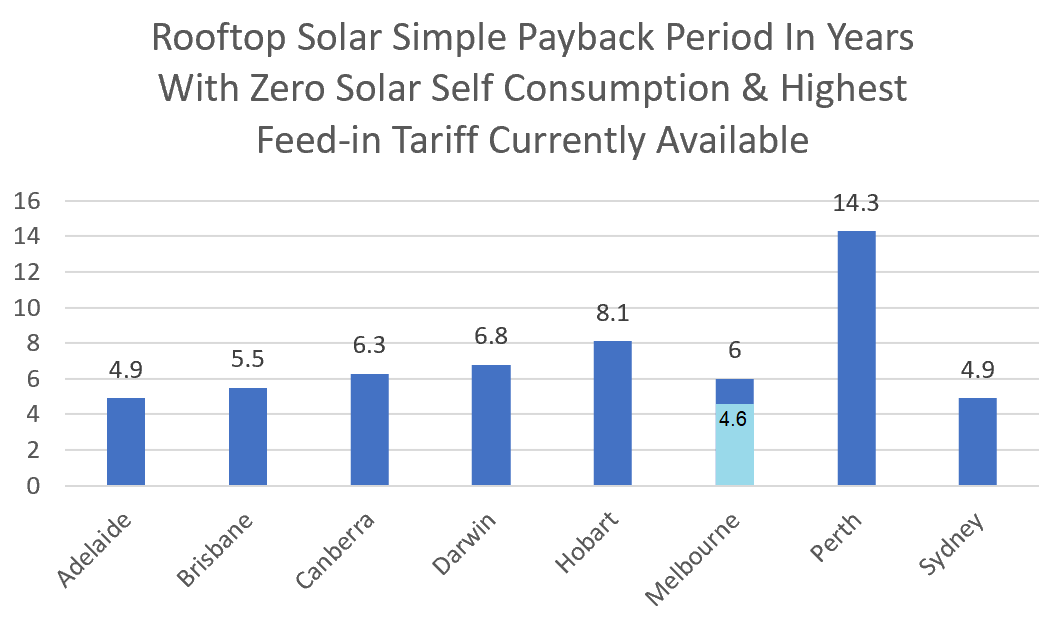
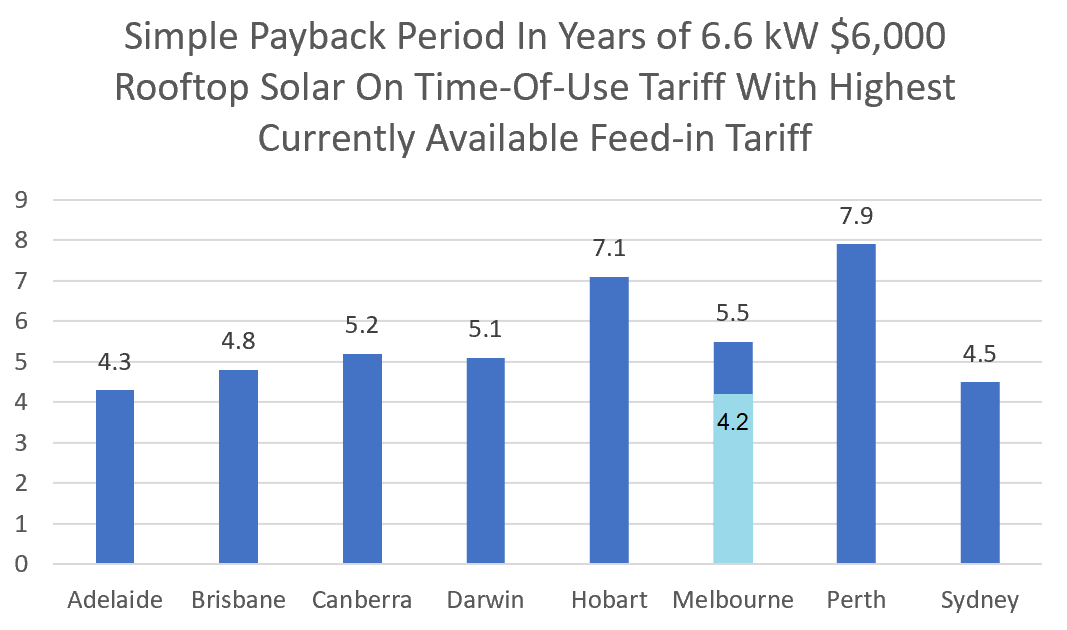
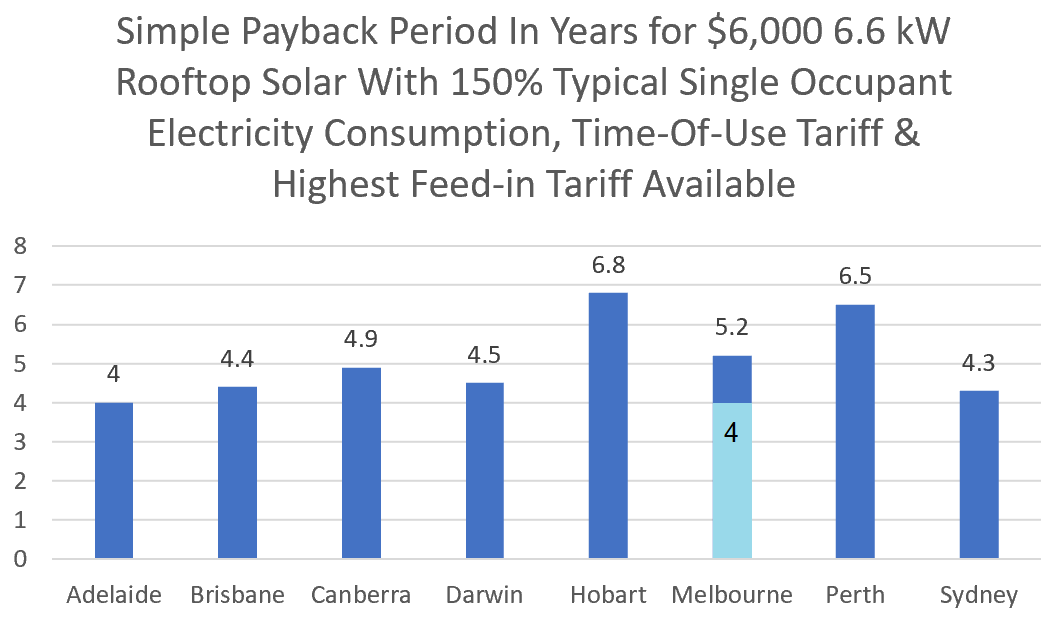
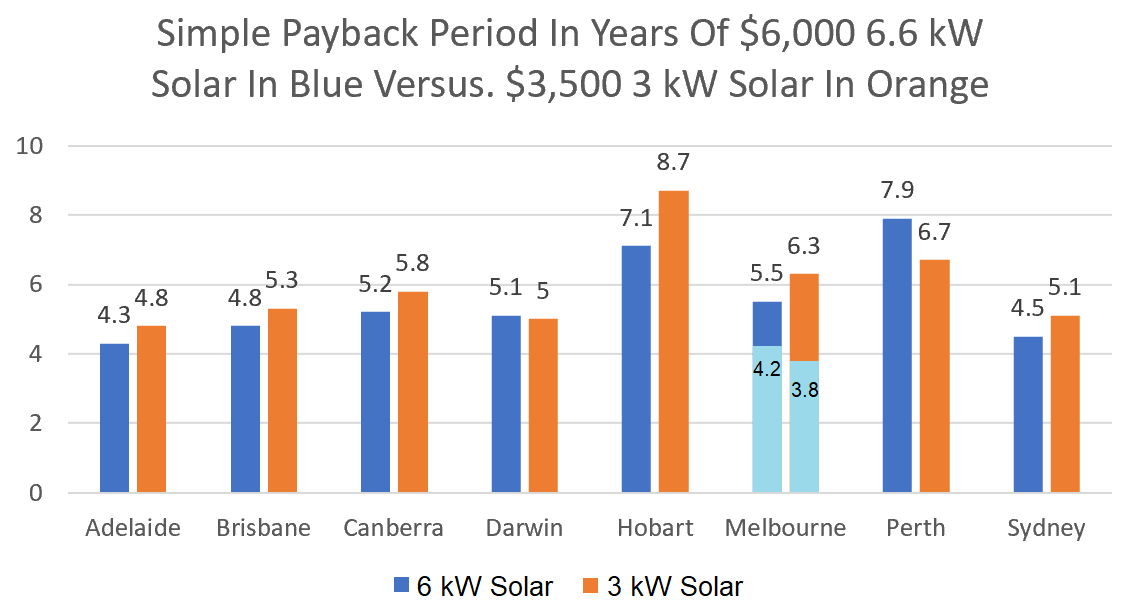
 RSS - Posts
RSS - Posts



Hi Ronald or one of your minions-I am part of your adoring public with a mild accusation which may be misplaced. To the best of my immense knowledge I have never read anything by you as to the wisdom of an aged fool (81 years old) buying a top of the range system, only to drop off the twig before getting the full benefit of the 30-40 years one would expect it to last. Would it not be sensible in my case to buy an average quality system which should last my distance and feed the chariot that will convey me to lucifer’s abode?
The worst thing of all would be to have a crap system installed at at 81 which causes you headaches when you should be enjoying the sunset years of your life. Nobody wants to go through the hassle of dealing with a dodgy system at any point. So while it can definitely make sense for you to not go for premium panels with 40 year warranties, it’s still vital to avoid shonks. But you get a system at a budget price that’s well installed and uses low cost but reliable hardware, then you’ll be getting one that…
(a) Is very unlikely to have any problems.
(b) If there is a problem, the installer will fix it quickly because you got it from an installer who cares about their reputation and the quality of their work who won’t leave you in the lurch.
(c) It will work well for years to come for the people who live in your place after you.
If you get quotes through us here…
https://www.solarquotes.com.au/quote/start/
…when it asks “What type of system are you after?” choose the option — “A good budget system.” This way you’ll get quotes from installers we know do good quality work and they’ll know you’re after a low cost system. This way you can get a solar system that isn’t expensive but you can be confident will operate without problem for however long you have left. Depending on where you are and how difficult your roof is to install on, you may be able to get a good quality system for considerably less than the prices I used in the article.
Ooh cool. Not that I’m looking to buy solar or anything, but this seems like an argument right up my alley! :|)
Scenario A) The worst case scenario might be ‘unrealistically bad’ in your opinion, but provides a raw baseline, and honestly it’s the easiest thing to calculate as a RoI.
Scenario B) Typical consumption for a single occupant household? Is that for a single working never at home household, or a single not working always at home household? Slight difference!
Scenario C) Crank the AC on and switch everything to high – we need to burn power else the grid will implode and we can’t get our money back on solar.
Sweet image. Anyone know where it’s from? I’m guessing a movie but it’s not ringing any bells :-C
According to WattEver.com.au
SA: 13.0c from 1st Energy for systems of up to 10KW inverter capacity
QLD: 12.0c from AGL for PV systems of up to 10kW
(1st Energy offer 11.0c for systems of up to 10KW inverter capacity)
ACT: 12.0c from ActewAGL for systems of up to 10KW inverter capacity
NT: 11.0c from Rimfire Energy
TAS: 10.0c from 1st Energy for systems of up to 10KW inverter capacity
VIC: 11.7c from 1st Energy for systems of up to 10KW inverter capacity
WA: 7.1c from Horizon Power for systems of up to 10KW inverter capacity
NSW: 15.0c from ActewAGL for systems of up to 10KW inverter capacity
AGL (which isn’t ActewAGL?) offers 12.0c for PV systems of up to 10kW
(The main concern here is in determining whether unknown companies are reliable – product reviews for even known companies tend to be brutal. The alternative is sticking with a reliable trustworthy company that offers new contracts at [shudder] 5c per kWh)
A rise in FiT is good news for solar owners. And if folk are not locked into contracts they can always switch when the FiT goes up.
Huh what do you know, Dumbleyung is actually a place!
Interesting. Opting for a smaller than 6.6 kW system doesn’t proportionately shrink its cost. Does the inverse hold true? Is a 13.3 kW system less than twice the cost of a 6.6 kW system? Plus on really cloudy or rainy days, solar generation can be less than required to cover your AC, or even your jug or your microwave or … If you want to be self sufficient, small is too small.
Higher FiT means higher usage charges. Is this only a 2c difference though? A quick search returns a 3c/kWh FiT plan charging 18.14 c/kWh, a 5c/kWh FiT plan charging 22.68 c/kWh, and a high FiT charging 25.157 c/kWh for supply above >15 kWh.
To any one who is considering Solar take my word for it and do it. you won’t regret it. when my late husband and I first started our home in Sunday creek, near Broadford Vic we used Battery and Generators not efficient. then we moved to Clydesdale in mid Vic. twice we contacted different Power Co.’s and the first Quote to get power to the edge of the property, was $25,000 years later the house was half built and we tried again the power co quoted $ 45,000 We stuck with Solar and Battery back up along with a generator. We never went without cooling or heating, and now I’m living in Wodonga so my family can watch over me and already I’ve gone Solar. (SUNRISE) that’s how much faith I have in it, I was about 32 when we first went solar, now i’m heading for 79 and I’m still saying solar, it can have its problems but they are small. thank you Sunrise, and Solar Quotes
I went through SolarQuotes to get my system installed in April 2019. I chose middle of the range products. My house is next door to a place with several Pine trees so there is shade on the the roof at times. The installer suggested a no cost change and that was shade tolerant panels. Its a standard 6.6kW system
Then I had to deal with Origin Energy. Every year is a hassle. So my FiT is 21c/kWh.
I am single. And as of Late November I had a credit of $1,600. So $1,000 came out and reduced my Mortgage by 4%
I used the SQ Pay Back system and mine came out to 4 years
21 c/kWh? That’s an amazing FiT. Is that from Origin? If so, is it a legacy FiT\long term contract?
Single person hh in Brisbane. Installed 6.6kw August 2020. Consumption vs grid usage now around 50:50 most days Not had electricity bill since installation and earned over $1600 in rebates for power sold to grid.
My payback time is way less, I changed habits such as doing laundry etc to use my solar and recommend it for single household. My next car will be electrical though that’s a few years away yet.
“If a demand tariff suits your household, that’s great. But, for every residential demand tariff I’ve looked at, you’d have to have a raisin in your braincase to want one.”
Hey Roland, does your retailer have to take you off a demand tariff if you ask them? I’m on an AGL demand tariff in Queensland.
I believe you can change to a time-of-use tariff without too much trouble.
Hello I realize you’re not here, but I live in Oklahoma and I’m considering solar. I live alone and basically only run my fridge 24/7 and TV when I’m home and ceiling fan and radio for my dogs when I’m away during the day. I do have four dogs and when it gets hot, I’d like to leave the AC on all day for them. I never run it at all now due to cost. Usually at night I can open windows and turn on the attic fan to suck in cooler air. I’m just leery of what you call shoddy installs plus I likely can’t get the rebates since they are paid with income tax payments. My problem is I always get a refund, so I will never be able to get their refunds. My quotes for 12-16 panels has been $27k to $36k as I want to make my own power and not owe anything to the power company. Heat; water heater and cook stove are all propane. So mainly the AC will be my biggest expense.
Biggest question is without being able to get the rebate of about $2,500, does it make any sense for me, a single senior, to get solar? Oh I’m also going with a ground mount unit to avoid any future roof issues.
I also wonder after the 20 year life expectancy, how difficult will it be to dispose of them? I’m on an acrage here, so I suppose I could bury them? Of course I won’t be alive then, but if the kids inherit it, will it be a curse? A friend just told me yesterday that there is a market for used panels among farmers buying the used panels.
Hi Steve
If you are being quoted $27,000 to $36,000 US dollars for what we’d call a small solar system, I’m afraid it makes no financial sense for you to get solar. The good news is the US rooftop solar market can’t stay that expensive forever.